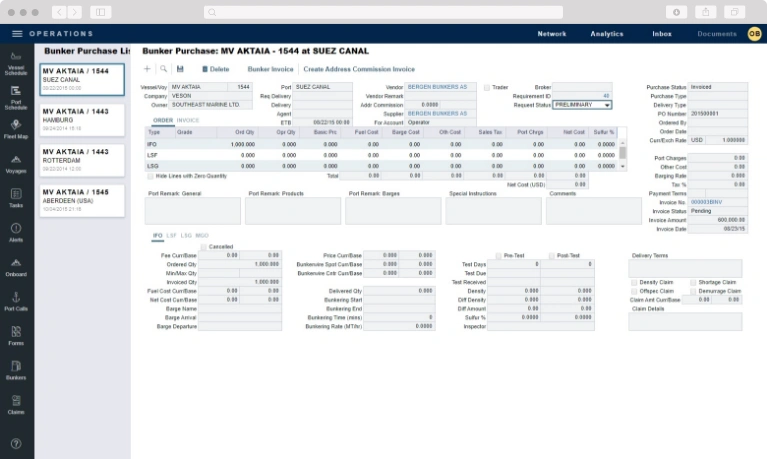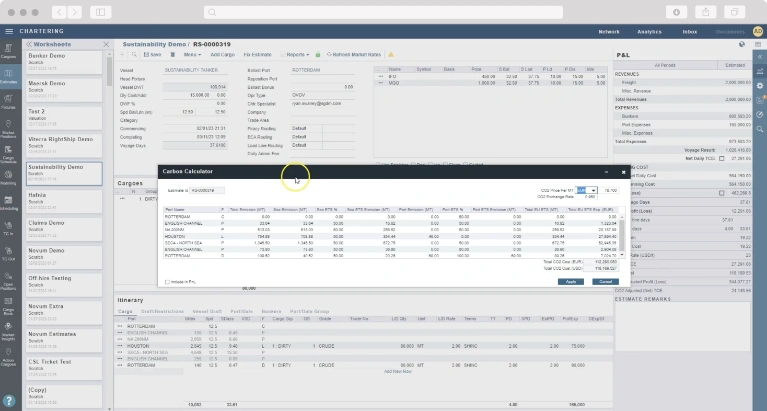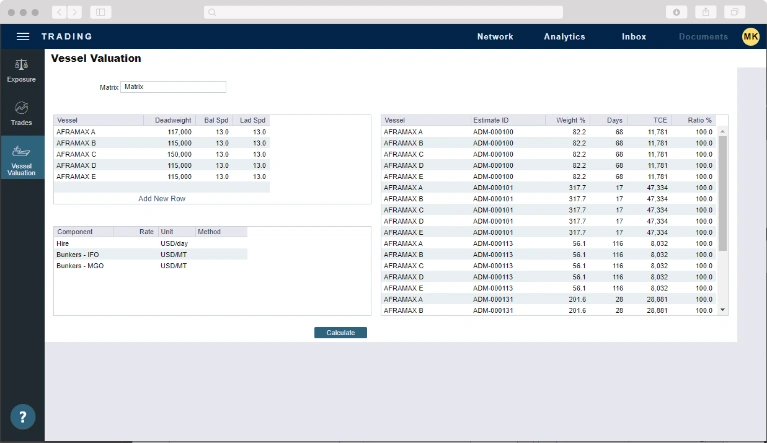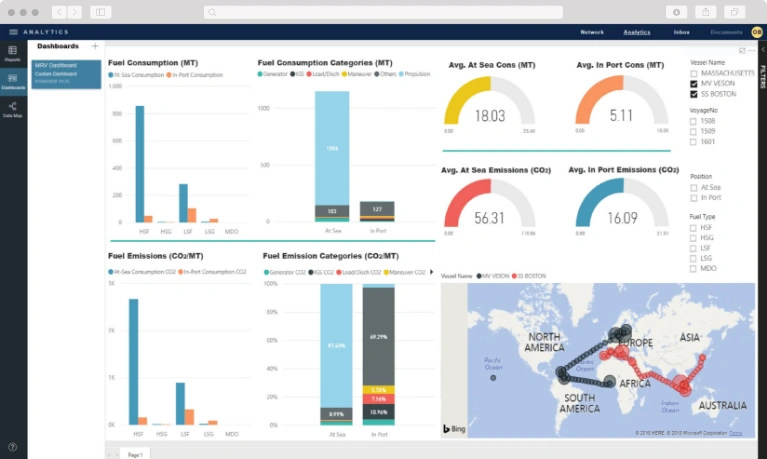Optimize fuel efficiency and contain one of the largest cost drivers of the modern maritime shipping voyage.
- Introduction
- Our clients
- Commercial impact of bunker management
- By the numbers
- How IMOS helps
- Related solutions
- Frequently asked questions
- Relevant resources
- Featured experts
- Contact us
Struggling to manage fuel costs, exposure, and efficiency in a scalable and data-driven way? Allow us to help you navigate.
Bunker management is essential to the success of any commercial maritime shipping organization. From bunker management’s integral role in executing voyages and moving cargoes to its broader implications for exposure, profitability, and environmental stewardship, no single element of seaborne trade has as much of an impact as the procurement and consumption of marine fuel. Heightened fuel prices and complex environmental regulations have further intensified the importance of effective bunker management—requiring a powerful blend of market-linked data, accurate voyage planning, exposure management, and operational insight.
IMOS and Veson’s suite of data and analytics solutions enable a more agile and efficient approach to bunker management from initial procurement to swaps, utilization throughout the voyage, management of the associated exposure, and financial analysis. As fuel practices in the industry continue to evolve, and alternative fuels increase in adoption, Veson’s sustained pace of innovation and expertise in the commercial voyage will continue to keep clients ahead.
Meet some of our clients.

“Since bunkers have a tremendous impact on profitability and payout, being able to respond in real-time is a huge benefit. We will continue to work with Veson to use information in the smartest possible way.”
— Jesper Mortensen
Chartering Manager, Hafnia Management A/S
Bunker management has an outsized impact on commercial maritime shipping performance.
Veson’s robust IMOS platform and high-powered data solutions enable our clients to confidently navigate the many facets of bunker management. Let’s examine four critical success factors impacting how today’s maritime organizations procure, use, and manage fuel.
Efficiency and consumption
Efficient bunker consumption is a central tenet of effective bunker management. Achieving efficient consumption involves precisely tracking fuel usage, monitoring vessel performance, and implementing strategies to minimize unnecessary fuel burn. This requires a robust bunker management workflow alongside comprehensive reports to understand and optimize performance.
Regulatory adherence
Compliance with maritime fuel regulations, including global standards like IMO 2030 and regional sulfur emission regulations, continues to become more important and more complex as regulatory standards rise. Commercial freight management solutions should powerfully support compliance with applicable regulations through real-time data monitoring, robust reporting, and the rapid development of new capabilities to enforce regulatory standards.
Environmental impact and alternative fuels
The maritime industry is increasingly focusing on minimizing its environmental impact by enhancing consumption efficiency and embracing alternative fuels like LNG, biofuels, and hydrogen. A comprehensive bunker management workspace is essential to this effort and should be capable of supporting both traditional and alternative fuels. By integrating commercial insights with environmental considerations, a proper platform enables fleets to simultaneously advance operational, financial, and environmental objectives.
Cost optimization and exposure management
Navigating the volatile maritime fuel market demands strategic cost optimization and effective exposure management. IMOS empowers bunker desks to strategically plan bunker procurement, analyze market trends, and predict price fluctuations. Additionally, we provide advanced exposure management solutions to help mitigate the financial risks associated with fuel price volatility. This comprehensive approach ensures operational efficiency and significant cost savings.
Technological advancements
Technological innovation is transforming bunker management, introducing new integration points for freight management platforms. This transformation is exemplified by solutions like ZeroNorth and BunkerMetric, which blend advanced fuel monitoring systems with AI-driven predictive analytics. These cutting-edge technologies are crucial for modern maritime shipping organizations, and a maritime platform should make it easy to form robust, flexible integrations.
Tell us about your bunker management challenges
By the numbers.
According to recent reports from Veson and third parties:
229 million
The global marine bunker market size is 229 million metric tonnes.3
40-60%
Bunkers represent up to 40-60% of ships’ total operating costs.1
2030
Upgraded bio-oil and liquefied bio-methane are the most promising alternative maritime fuels with the potential to be almost as economical as using heavy fuel oil (HFO) by 2030.4
“Bunker management has always been a key focus for IMOS because of its massive impact on commercial outcomes. But now, bunker management is more than a cost driver linked to the P&L—it is a strategic function of the modern maritime shipping business. At Veson, we integrate financial and environmental bunkering considerations throughout the workflow and provide clients with a dedicated workspace for data-driven bunker management. At the same time, we are working collaboratively with our clients as they navigate the future of alternative fuels.”
— Eric Christofferson
Chief Product Officer, Veson
Adapt to the future of bunker management with Veson solutions.
Veson solutions bring new efficiency and insight to bunker management. Here’s how.

Integrated bunker management workspace
IMOS delivers a dedicated workspace and connected workflow for bunker management. From tracking stem requirements to managing quantity requests, stakeholders can streamline communication while accessing the dedicated functionality they need to work more efficiently without ever losing sight of their core commercial workflow and voyage P&L.

Full-lifecycle decision support
More effective bunker management extends well beyond the bunker desk, affecting decisions in chartering, operations, trading, and beyond. In addition to transforming the efficiency of the bunker desk, IMOS supports better decision making with contextual decision support—from voyage planning and route optimization to vessel performance monitoring, exposure management, and post voyage analysis.

Market-linked insight
When it comes to bunker management, the more insight the better. Veson complements its comprehensive IMOS platform with powerful data solutions that shed light on vessel fuel efficiency, congestion patterns, bunker price fluctuations, and more. Veson makes these data readily available inside the maritime shipping workflow where they can make the greatest impact.

Regulatory reporting
IMOS by Veson offers advanced reporting capabilities for bunker management, streamlining compliance with key regulations like the IMO 2020 sulfur cap, MARPOL Annex VI, and EU MRV. By automating the tracking and reporting of fuel consumption and emissions, IMOS ensures accuracy and simplifies the complex process of adhering to evolving international and regional environmental standards.
Discover related solutions.
Bunker Management
Centrally manage and mitigate fuel costs in a dedicated workspace.
Voyage Planning
Identify and plan voyage routes that optimize routes and mitigate consumption.
Exposure Management
Proactively manage your exposure to bunker market fluctuations.
Fuel Efficiency Information
Access comprehensive insight on vessel fuel efficiency and consumption.
Market Intelligence
Harness data on port congestion, turnaround times, and more to make fuel efficient decisions.
Frequently asked questions.
Frequently asked questions about bunker management.
How should a freight management solution support bunker management?
A comprehensive freight management solution should offer a robust bunker management workspace equipped with advanced tools and the ability to share information seamlessly across stakeholders. In addition, a freight management solution should support more informed fuel-related decisions throughout the entire workflow, from chartering through operations. Configurable compliance reporting is also essential, particularly in adhering to bunker-related regulations. An often-overlooked capability is integrated exposure management, which enables the proactive management of bunker-related risk with a full view into its P&L impact. Last, but not least, a freight management solution should incorporate contextually relevant market data that is both comprehensive and accurate, including but not limited to insights on bunker indices, port congestion, vessel fuel efficiency, and more.
What is the role of other solutions in solving this challenge?
The freight management solution is essential to addressing bunker management, but it is not necessarily sufficient. At Veson, we firmly believe that maritime shipping technologies are better together, which is why we embrace the power of robust and flexible integrations with adjacent and supportive technologies. Our Veson Partner Network, which delivers turnkey and fully supported integrations to our client community, includes a variety of technology providers that contribute to the efficiency and effectiveness of bunker management including ZeroNorth, which delivers voyage optimization software that empowers tramp shippers to reduce bunker spend, and BunkerPlanner, which empowers decision makers to optimize complex and impactful bunkering decisions through advanced analysis.
Why has bunker management evolved into a strategic priority for maritime shipping organizations?
Bunker management has evolved from a tactical function to a strategic one due to its outsized impact on the financial performance of shipping companies and its heightened volatility. In an industry where margins are exceedingly thin, effectively managing key cost drivers like bunkers is indispensable to commercial success. In addition, maritime shipping organizations are responding to heightened volatility by collectively embracing more proactive approaches to bunker exposure management. Finally, the strategic emphasis on decarbonization and its relationship with bunker management has further elevated its importance. This strategic shift reflects an understanding that effective bunker management is not just about cost control but also about operational and environmental performance.
How is bunker management expected to change in the future?
Bunker management continues to evolve significantly in response to ongoing regulatory changes and environmental standards. This evolution is already driving increased adoption of cleaner fuels and alternative technologies, such as LNG, biofuels, or electric propulsion systems. Alternative fuel types and associated regulations will undoubtedly introduce new commercial considerations for maritime shipping professionals. Beyond regulatory compliance, this shift also encompasses significant operational and infrastructural changes, requiring maritime organizations to adapt not just in policy but also in practice. The role of technology providers is pivotal in this context, as they are instrumental in facilitating these transitions, offering solutions that manage the complexities of new fuel types and supporting the infrastructural overhaul needed for their adoption. Veson actively collaborates with our client base to anticipate and prepare for these future developments, adapting a step ahead of the industry.
Do you have any additional questions that we didn’t answer here? We’d love to answer them. Contact us to connect with a maritime shipping expert.
Explore relevant resources.
Bunker Management Use Case
Hedge bunker risk, plan for future bunker stems, consider sustainability, and adapt to change.
4 Ways to Develop a Data-Driven Bunker Procurement and Management Strategy
Optimize your bunker management approach to yield financial and environmental dividends.


